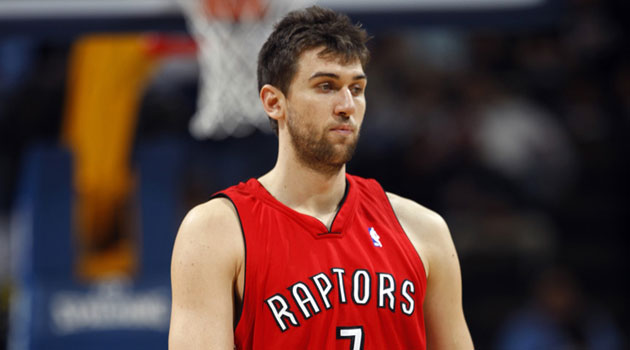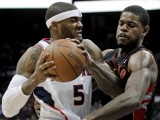
Yesterday, reader aaron pointed out that Bargnani can flourish now that Bosh has vacated his stronghold on his offensive post-position. This got me thinking, is the long-awaited arrival of Bargnani as simple as that? Could it really be that he’s been playing “out of position” for so long that he’s become a victim of the Raptors’ dedication of building around Bosh? I don’t have the time or resources to fully test that theory by going through every game Bargnani played without Bosh and do a statistical analysis that could provide a boolean answer. So I’ll start by pulling up Bargnani’s numbers from the post-AllStar game and the tail end of last season when the Raptors were in pure pressure games without Bosh, who had his face “broken” in the Cleveland game.
Post All-Star
Tail End
After the Chicago game, our season was over so the stretch that I’ll focus on are the games against Cleveland, Boston, Atlanta and Chicago. If this team has played any true “clutch” games over the last two years, these have been it. As the Bosh variable is being controlled by him not playing, let’s see what Bargnani averaged:
FG: 42%
3FG: 28.6%
FT: 32-43 = 74%
REB: 5rpg
Blocks: 1.28bpg
TO: 1.28tpg
Scoring: 15.3ppg
Now, ask yourself if Bargnani averaged the above numbers for the duration of the season, would you be satisfied? That’s a 16/6 center averaging two blocks a game, not too shabby, but is it worth investing in? As a random comparison, Paul Millsap delivers 18/9 with 1.2 blocks per game for the duration of the season. I realize I’m comparing apples and oranges here, but remember that we’re testing what could Bargnani do “on his own” out there. I also hate to be a stickler for rebounding, but in the last four games the Raptors were -4, -4, -7 and -8, which didn’t help the cause. They also lost the rebounding battle on most of the post All-Star games as well. As much as we all acknowledge that Bargnani will never be a great rebounder, the occasion here called for the remaining big gun on the team to step up, and he delivered a rebounding rate lower than his season average of 6.2. The same is true for scoring, which went down by 1.9 points. Believe it or not, Bosh being there actually helped him.
Leaving stats from this small sample size aside, the theory that the space vacated by Bosh will result in Bargnani playing closer to the rim is idealistic, mostly because Bosh was never a player that forced the Raptors into any sort of predictable set formation. He was a perimeter oriented player for the Raptors that worked outside-in as much as anybody, so to think that there wasn’t an opportunity for Bargnani to establish his game inside is incorrect. Yesterday we discussed FT rate and saw that Bosh had a much higher rate than anyone else, yet, the usage rate of Bargnani and Bosh is similar with Bosh having a slight edge – 25.0% to 22.5%. So Bargnani playing the way he did wasn’t a matter of the Raptors not involving him enough or not giving him enough opportunities to make his mark; it had to do with Bargnani choosing to play the way he did.
If Amir Johnson becomes the starter one could make a case that he’ll play in the post far more than Bosh ever did, thus “clogging” the area for Bargnani even more. The same is true for Ed Davis or Joey Dorsey, these aren’t power forwards that like to play anywhere but around the rim, so if Bargnani and the Raptors are expecting a whole lot of difference in terms of floor spacing, it’s unlikely to happen. At the end of the day, when Bargnani is given the ball at the wing or the elbow or the low-block, the decision to take a high-percentage shot is mostly up to him, with coaching playing the usual part.
What is a candidate for change is the amount of ball movement per possession. This is because Chris Bosh was a very poor passer and could not read defenses well at all. There have been countless possessions where Bosh had a chance to read a situation properly, make the right pass which would’ve led to a higher percentage shot. Instead, his basketball IQ got in the way and he often took a jumper or put the ball on the deck hoping for a foul. Could Bargnani be an improvement in that regard? For that opportunity to even present itself, Bargnani will need to be double-teamed, otherwise it’s just a simple isolation situation. Unless he is able to put pressure on the defense forcing help to rotate over, he can never be a player that can make his teammates better, which Bosh did, however slightly.
For the sake of argument, let’s say that Bargnani manages to attract a double-team, what now? Is he better at making the defense pay for their indiscretions or will he, like Bosh, bail them out by either 1) succumbing to pressure and turning the ball over, 2) taking an ill-advised shot, or 3) making the incorrect pass out of the double, thus resetting the defense resulting in the offense gaining nothing. I don’t know how to determine that (open for ideas here?) except to look at his assist numbers, which anyway you slice them are poor. I’ll also throw in some stats from Nowitzki and Okur just for kicks.
- AST%: 6.1 (This is the percentage of teammates FGs that he assisted on. For a comparison, Nowitzki is at 13.0, Okur is at 10.0, and Biderins is at 6.6)
- APG: 1.2. For his career he’s averaged: 0.8, 1.1, 1.2 and 1.2, not much of an improvement at all. Nowitzki’s assists for the first four years: 1.0, 2.5, 2.1 and 2.4.
- AST PER 36: 1.3. Nowitzki is at 2.6 and Okur is at 2.1.
I don’t know what that Caliper test exactly concluded, but it wasn’t that his passing is great. Yes, he’s made some spectacular passes before and even gets in on the hi-low action from time to time, but it’s not consistent enough to be attributed as a strength and looked forward to. Maybe there is another metric that can prove that Bargnani is a much better reader of the game than what these numbers indicate, but I doubt it. Having watched practically every Raptors game that he’s played in over the last four years, his shot-selection and decision-making often leaves me cringing. The early 21-foot pull-up jumper is my least favorite move of of his, followed closely by any three-pointer where he hasn’t even looked to do anything else. Those are two plays that usually end in a bad result and happen with enough frequency that it leads me to believe that there aren’t any lessons being learned here, and that the adaptation that is paramount in player development isn’t happening, at least not fast enough for me to be excited about the prospect of Bargnani leading the charge next year.
Maybe it’s a psychological thing with him, Bosh’s departure might not open up space on the court, but it could in his mind? Huh? Or maybe it’s simply a matter of hoisting more shots? Perhaps 14.3 FGAs a game doesn’t cut it for him and if he ups that he’ll be more interested in playing defense and will be more comfortable making plays for others. I’m clutching at straws here, but any way one looks at it, the burden of proof of whether Bargnani can become the player he was touted to be rests solely on him, not anyone else. It is no-one’s “fault” that he’s been under-performing except his.
The coming season presents a different opportunity for Bargnani to excel, not necessarily a better one.




